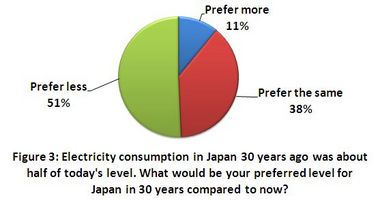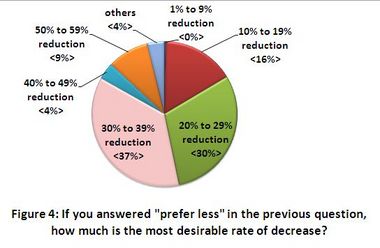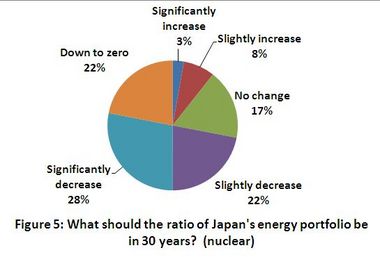May 13, 2011
New Survey Asks How Nuclear Accident Changed Public Awareness of Japan's Energy Future
Keywords: Newsletter
JFS Newsletter No.104 (April 2011)
The Federation of Electric Power Companies of Japan, an industry group of electricity providers, recently released its forecast on Japanese power consumption, stating that electricity demand has been increasing and will continue to rise. There are only 10 electric utilities nationwide, and one utility has a monopoly in each region of the country, supplying power to households and other small electricity consumers.
The Japanese government has up to now put nuclear power at the center of its energy policy, including a plan to increase the ratio of nuclear power in the overall mix of generating capacity from 31 percent in 2005 to 49 percent in 2030. But since the nuclear accident in Fukushima, there has been talk of reviewing Japan's Strategic Energy Plan, and this will likely mean some policy changes.
Noting the limits to the Earth, some citizens have challenged the notion of never-ending increases in the energy supply and electricity consumption. Up to now, however, this was not a mainstream opinion, and anti-nuclear or "de-nuclear" movements were limited to some citizen groups.
So far in Japan, even though consumers have the choice of using "Green Power Certificates," they have no choice but to use the electricity from their local power provider's power mix, because it is already determined for a given region. Unlike Sweden, where people can choose their source of power, the Japanese cannot simply tell the utility they want to use only power generated by wind turbines, for instance.
Another important point to note is that, besides having no choice over electricity source, people have rarely experienced power outages in Japan, and when they do occur they are among the shortest in the world. For people in Japan, until the recent disaster, the electricity supply has been stable and available whenever and in whatever quantity they wanted it. This situation has contributed to a general lack of interest in where their energy comes from.
Against this backdrop, the country was hit by the devastating Great East Japan Earthquake of 2011 (also known as the Tohoku earthquake and tsunami). The day of the earthquake, trains stopped running, many people had to walk home for hours and power outages were widespread.
Moreover, the earthquake caused the accident at the Fukushima Daiichi Nuclear Power Plant owned by Tokyo Electric Power Company (TEPCO), and many nuclear power plants and thermal electric power plants were disabled, which led to a reduced electricity supply. In the ensuing weeks, power utilities implemented rolling blackouts (referred to as "planned blackouts" in Japanese) on an area-by-area basis. (Cynics called them "blackouts without a plan," because they were neither well planned and nor well communicated.) The situation has negatively affected industry and people's livelihoods in eastern Japan. It is now forecast that during peak hours in the quickly-approaching summer months, the electricity supply will meet only 75 percent of total demand. Thus, the people are told that a large-scale power saving scheme is necessary. If a good demand-supply balance is not established, there is concern that large-scale power outages could occur this summer.
Almost everyone in Japan is now talking about electricity and energy conservation -- topics that turn up constantly now in the news, on television talk shows, in the workplace, at home, and in the community. The consequences of the Great East Japan Earthquake and the nuclear disaster appear to have awakened the dormant energy awareness of the Japanese people.
Under the guidance of its president, Junko Edahiro, the Institute for Studies in Happiness, Economy and Society (ISHES) -- which JFS supports as a partner in sending out messages overseas -- commissioned a survey of citizens on April 5 and 6, 2011, about how the Great East Japan Earthquake and the accident at TEPCO's Fukushima Daiichi nuclear power plant has altered their awareness about Japan's energy future. Below are the results, published by ISHES on April 8.
The survey, conducted by Japanese online research company Macromill Inc., was completed by 1,045 citizens in their twenties through seventies, and the ratios of age group, sex, and domicile (city/town/rural) were in proportion with Japan's total population. It was noted, however, that responses from disaster-affected cities were low compared with the general ratio of population.
One of the questions people were asked was, "Did your thinking and opinion about Japan's energy supply change after the earthquake disaster and TEPCO's nuclear accident?" In response, 74 percent (about three-quarters) of respondents (774 people) said yes, showing that these events had a definite impact on many people's perspectives on Japan's energy policy.

The respondents who said that their thinking and opinions had changed were asked to elaborate on the reasons why. Of the total, 47 percent (360 respondents) said that their "confidence in the safety of nuclear power plant was shaken," and 24 percent (187 people) said that they had an "increased awareness of energy/electricity conservation".

From among the questions on energy, the survey focused on electricity, an essential component in everyday life and the economy, and the two aspects of "quantity" (how much they use) and "quality" (how it is generated).
When realistically considering a shift in electricity sources, it is important to be aware of implementation timelines, because it often takes several years or even decades for the supply side to shift, especially with the building of new power plants. When we think about the energy future, we need to have a parallel timelines for "what we want to do immediately" and "what we want to do in the long run." The survey asked about people's thoughts about Japan's energy policy regarding the long term.
The first question was about quantity: "Electricity consumption in Japan 30 years ago was about half of today's level. What would be your preferred level for Japan in 30 years compared to now?" To this, 51 percent said "preferably less," 38 percent said "preferably the same," and 11 percent "preferably more".

Thus, more than half of respondents said that in the long run, Japan's power consumption should decrease. When asked about the most desirable rate of decrease, the majority said 30 to 39 percent, and the second largest group said 20 to 29 percent, an average of 28 percent.

The survey then asked about the "quality" of electricity. Respondents were shown two graphs of Japan's energy portfolio comparing now with 30 years ago (see reference data), and asked, "What should the ratio of Japan's energy portfolio be in 30 years?" They were also asked to indicate which energy sources in the portfolio -- hydro, natural gas, coal, oil, nuclear, and renewable energy (but not including hydro) such as solar, wind, and geothermal -- they thought should increase or decrease, and by how much, by indicating "significantly increase," "slightly increase," "no change," "slightly decrease," "significantly decrease," or "down to zero."
In terms of nuclear power supply 30 years from now, those who chose "down to zero" accounted for 22 percent of respondents, 28 percent said it should "significantly decrease," and 22 percent said it should "slightly decrease." In total, 72 percent of respondents, including those who chose "down to zero," thought that decreasing the use of nuclear power was preferable.

As for renewable energy sources such as solar, wind, and geothermal (except hydro) in 30 years, 93 percent of all respondents replied that it was best to increase these, while 78 percent said they should "significantly increase" and 15 percent said "slightly increase" (Figure 6).
The survey also asked about the rise and fall of the preferred ratio of other energy sources in the mix. Regarding hydro, 65 percent said that they hoped it would increase, 40 percent hoped natural gas would increase, 54 percent thought coal use should be decreased or cut to zero, and 66 percent hoped to see a decrease of oil use or that it be cut to zero (Figure 7).
The survey did not ask people to give their reasons for why they thought the ratio of each source should be increased or decreased, but it could be surmised that concerns about carbon dioxide emissions, resource depletion, and geopolitical risks -- plus the safety risks associated with radioactive substances -- could have been factors.
The survey suggests that the earthquake disaster and TEPCO's nuclear accident have definitely changed many Japanese people's views on the country's future energy supply, and that many people think that its power consumption should be reduced. As for their most preferred energy portfolio, nearly 75 percent thought that the nuclear power supply should be decreased or brought down to zero, while about 20 percent said nuclear power should be cut altogether. On the other hand, it became clear that many hope to have an increase in the renewable energy supply from sources such as solar, wind, geothermal, and hydro.
When pondering how to actualize the vision of a sustainable and prosperous Japanese society and economy, the issues of energy and power are critical. The survey revealed that many people prefer a life, economy, and society 30 years in the future where overall power consumption has decreased and energy comes mainly from renewables. Such a vision stands in stark contrast to the business-as-usual scenario of building many more nuclear plants -- especially with safety concerns so heightened -- and generating more and more electricity to meet ever-increasing power demand.
This survey by ISHES revealed a widespread desire to go in a different and more promising direction for Japan's energy future.
Written by Junko Edahiro
Related
"JFS Newsletter"
- 'Good Companies in Japan' (Article No.4): 'Eightfold Satisfaction' Management for Everyone's Happiness
- "Nai-Mono-Wa-Nai": Ama Town's Concept of Sufficiency and Message to the World
- 'Yumekaze' Wind Turbine Project Connects Metro Consumers and Regional Producers: Seikatsu Club Consumers' Co-operative
- Shaping Japan's Energy toward 2050 Participating in the Round Table for Studying Energy Situations
- 'Good Companies in Japan' (Article No.3): Seeking Ways to Develop Societal Contribution along with Core Businesses


